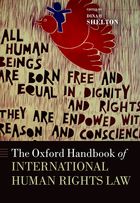 The Oxford Handbook of International Human Rights Law provides a comprehensive and original overview of one of the fundamental topics within international law. It contains substantial new essays by over forty leading experts in the field, giving students, scholars, and practitioners a complete overview of the issues that inform research and a "map" of the debates that animate the field. Each chapter features critical and up-to-date analysis of the current state of debate and discussion, assessing recent work, and advancing the understanding of all aspects of this developing area of international law. The Oxford Handbook of International Human Rights Law provides a comprehensive and original overview of one of the fundamental topics within international law. It contains substantial new essays by over forty leading experts in the field, giving students, scholars, and practitioners a complete overview of the issues that inform research and a "map" of the debates that animate the field. Each chapter features critical and up-to-date analysis of the current state of debate and discussion, assessing recent work, and advancing the understanding of all aspects of this developing area of international law.
Addressing all aspects of international human rights law, the Handbook consists of over forty chapters, divided into seven parts. The first two sections explore the foundational theories and the historical antecedents of human rights law from a diverse set of disciplines, including the philosophical, religious, biological, and psychological origins of moral development and altruism, and sociological findings about cooperation and conflict. They also trace the historical sources of human rights through comparative and international law by conducting a case study of the anti-slavery movement. Section III focuses on the law-making process and certain categories of rights. Sections IV and V examine the normative and institutional evolution of human rights, and discuss its impact on various doctrines of general international law. The final two sections are more speculative, examining whether there is an advantage to considering major social problems from a human rights perspective and, if so, how that might be done. Section VI analyses several current problems that are being addressed by governments both domestically and through international organizations, and issues that have been placed on the human rights agenda of the United Nations, such as state responsibility for human rights violations and economic sanctions to enforce human rights. The final section then evaluates the impact of international human rights law over the past six decades from a variety of perspectives.
The Handbook will be an invaluable resource for scholars, students, and practitioners of international human rights law. It provides the reader with new perspectives on international human rights law that are both multidisciplinary and geographically and culturally diverse. It should become the new standard reference work in this area.
Contents:
I. Theoretical Foundations
1: M. Christian Green and John Witte: Religion
2: Siegfried Van Duffel: Moral Philosophy
3: Christopher A. Robinson: Biology
4: Brian S. Turner: Sociology
5: Robin Bradley Kar: Psychology
6: Mark Goodale: Cultural Anthropology
II. Historical and Legal Sources
7: Paul Gordon Lauren: Justice and Rights in Legal Texts from Hammurabi to the 18th Century
8: Michael O'Boyle and Michelle Lafferty: Constitutions and General Principles as Sources of Human Rights Law
9: Jenny Martinez: The Anti-Slavery Movement and the Rise of Non-government Organizations
10: Annemarieke Vermeer: Diplomatic Protection as a Source of Human Rights Law
11: Gerd Oberleitner: Humanitarian Law as a Source of Human Rights Law
12: Janelle Diller: The International Labor Movement
13: Peter Kovacs: The League of Nations Precedents
III. Structural Principles
14: Paolo Carozza: Human Dignity
15: Gerald Neuman: Subsidiarity
16: Johan van der Vyver: Sovereignty
17: Rudiger Wolfrum: Solidarity
18: Jarlath Clifford: Equality
19: Yutaka Arai-Takahashi: Proportionality
20: Christian Tomuschat: Democracy and the Rule of Law
IV. Normative Evolution
21: Bertram Ramcharan: The Law-Making Process: From Declaration to Treaty and Custom
22: Martin Scheinin: The Concept of "Core" Rights and Obligations
23: Erika de Wet: Jus Cogens and Obligations Erga Omnes
24: Dinah Shelton and Ariel Gould: Positive and Negative Obligations
V. Institutions and Actors
25: Miloon Kothari: From Commission to Council: The Evolution of UN Charter Bodies
26: Nigel Rodley: The Role and Impact of Treaty Bodies
27: Cecilia Medina: International Tribunals: Interpreting or Creating Rights and Obligations?
28: Christof Heyns and Magnus Killander: Thinking Globally, Acting Regionally: Universality and the Growth of Regional Systems
29: Nisuke Ando: National Implementation and Interpretation
30: David Weissbrodt: The Role and Responsibility of Non-State Actors
VI. Human Rights and General International Law
31: Malgosia Fitzmaurice: Interpretation of Human Rights Treaties
32: Ramesh Thakur: Using Armed Force to Prevent or Halt Human Rights Violations: The Responsibility to Protect and Humanitarian Intervention
33: Chimene Keitner: Transnational Human Rights Litigation: Jurisdiction and Immunities
34: George Lopez: Enforcing Human Rights through Economic and Other Sanctions
35: Sarah Joseph: Trade, Investment, and Human Rights
VII. Assessments
36: Francisco Lopez-Bermudez: Developing and Applying Human Rights Indicators
37: Gisella Gori: Evaluating Compliance with Judgments and Recommendations of Human Rights Tribunals
38: Fiona McKay: What Outcomes for Victims?
39: Juan Mendez and Catherine Cone: Does Human Rights Law Make a Difference: Lessons from Latin America |